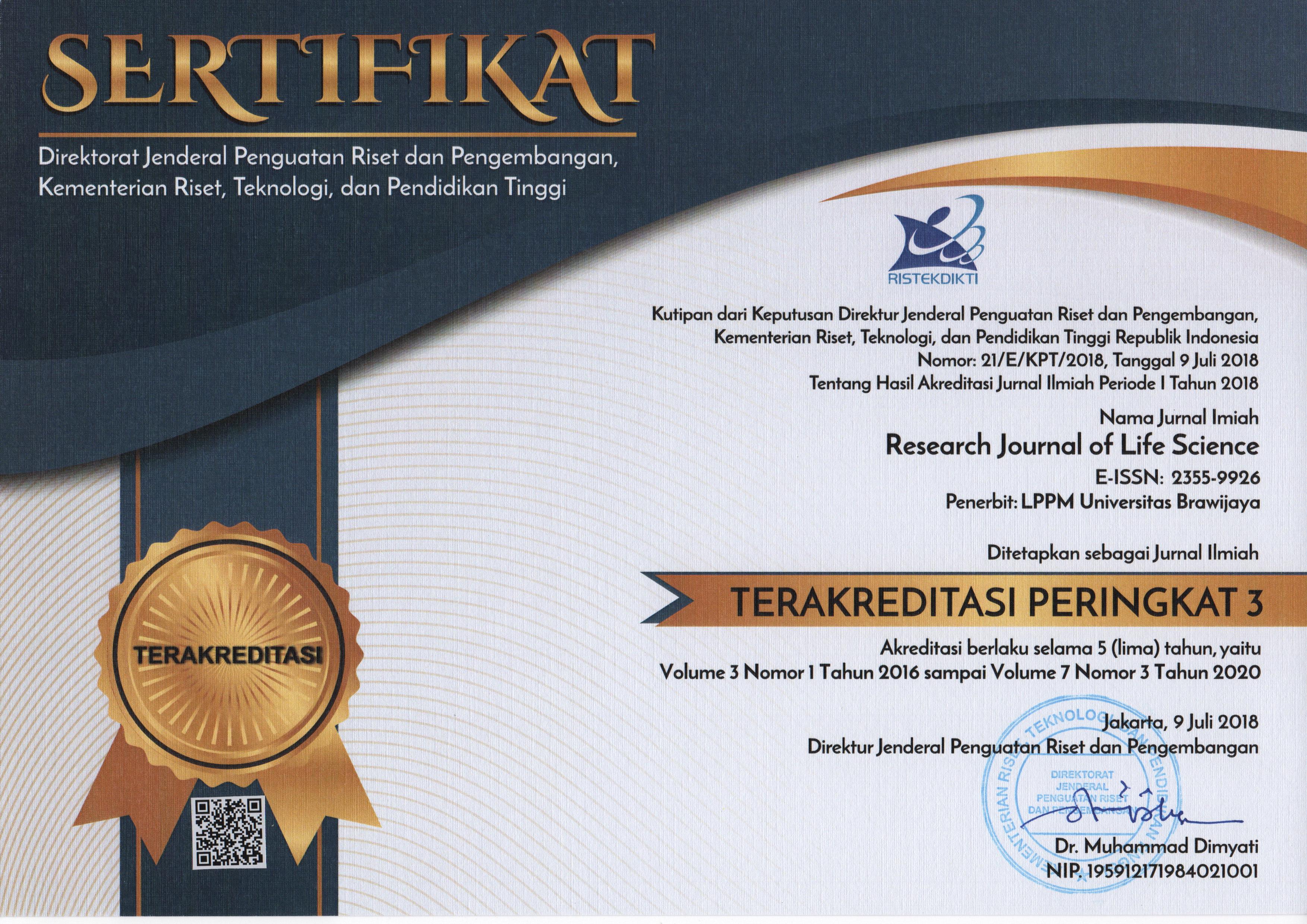Diversity of Ant Spesies (Hymenoptera: Formiciidae) in Refugia Plants Combination on Ratoon Sugarcane
Abstract
Keywords
Full Text:
PDFReferences
Asmoro, P. P., Dadang, Pudjianto, & Winasa, I. W. (2021). Olfactory Response of Plutella xylostella (Lepidoptera: Yponomeutidae) Adults to Refugia Plant. IOP Conference Series: Earth and Environmental Science, 752(1), 0–7. https://doi.org/10.1088/1755-1315/752/1/012039
Bengtsson, J. (2015). Biological control as an ecosystem service: Partitioning contributions of nature and human inputs to yield. Ecological Entomology, 40(S1), 45–55. https://doi.org/10.1111/een.12247
Butler, J. R. A., Brown, W. Y., & du Toit, J. T. (2018). Anthropogenic food subsidy to a commensal carnivore: The value and supply of human faeces in the diet of free-ranging dogs. Animals, 8(5). https://doi.org/10.3390/ani8050067
Byk, J., & Del-Claro, K. (2010). Nectar- and pollen-gathering Cephalotes ants provide no protection against herbivory: A new manipulative experiment to test ant protective capabilities. Acta Ethologica, 13(1), 33–38. https://doi.org/10.1007/s10211-010-0071-8
Chin, Darren W. M. (2017). Pavement Ant (Tetramorium sp. E) Territoriality: Dominance, Competition and Implications for Control Methods. Purdue University ProQuest Dissertations Publishing, 10271948.
Crowder, D. W., & Jabbour, R. (2014). Relationships between biodiversity and biological control in agroecosystems: Current status and future challenges. Biological Control, 75, 8–17. https://doi.org/10.1016/j.biocontrol.2013.10.010
Cruz, N. G., Cristaldo, P. F., Bacci, L., Almeida, C. S., Camacho, G. P., Santana, A. S., Ribeiro, E. J. M., Oliveira, A. P., Santos, A. A., & Araújo, A. P. A. (2018). Variation in the composition and activity of ants on defense of host plant Turnera subulata (Turneraceae): strong response to simulated herbivore attacks and to herbivore’s baits. Arthropod-Plant Interactions, 12(1), 113–121. https://doi.org/10.1007/s11829-017-9559-8
de Oliveira, R. de F., de Almeida, L. C., de Souza, D. R., Munhae, C. B., Bueno, O. C., & Morini, M. S. de C. (2012). Ant diversity (Hymenoptera: Formicidae) and predation by ants on the different stages of the sugarcane borer life cycle Diatraea saccharalis (Lepidoptera: Crambidae). European Journal of Entomology, 109(3), 381–387. https://doi.org/10.14411/eje.2012.049
Del-Claro, K. (2004). Multitrophic relationships, conditional mutualisms, and the study of interaction biodiversity in tropical savannas. Neotropical Entomology, 33(6), 665–672. https://doi.org/10.1590/s1519-566x2004000600002
Diamé, L., Rey, J. Y., Vayssières, J. F., Grechi, I., Chailleux, A., & Diarra, K. (2018). Ants: Major functional elements in fruit agro-ecosystems and biological control agents. In Sustainability (Switzerland), 10(1), 1–18. https://doi.org/10.3390/su10010023
Dinardo-Miranda, L. L., & Fracasso, J. V. (2013). Sugarcane straw and the populations of pests and nematodes. In Scientia Agricola, 70(5), 369–374. https://doi.org/10.1590/s0103-90162013000500012
Eubanks, M. D., & Finke, D. L. (2014). Interaction webs in agroecosystems: Beyond who eats whom. In Current Opinion in Insect Science, 2, 1–6. https://doi.org/10.1016/j.cois.2014.06.005
Koch, F. (2008). Goulet, H. & Hubert, J. F. (1993): Hymenoptera of the world. An identification guide to families. - Research Branch, Agricultural Canada Publication. Canada Communication Group-Publishing, Ottawa. 668 Seiten. Preis: FF 412,-. ISBN 0-660-14933-8. Deutsche Entomologische Zeitschrift, 42(2). https://doi.org/10.1002/mmnd.19950420212
Gray, C. L., & Lewis, O. T. (2014). Do riparian forest fragments provide ecosystem services or disservices in surrounding oil palm plantations? Basic and Applied Ecology, 15(8), 693–700. https://doi.org/10.1016/j.baae.2014.09.009
Hagen, M., Kissling, W. D., Rasmussen, C., de Aguiar, M. A. M., Brown, L. E., Carstensen, D. W., Alves-Dos-Santos, I., Dupont, Y. L., Edwards, F. K., Genini, J., Guimarães, P. R., Jenkins, G. B., Jordano, P., Kaiser-Bunbury, C. N., Ledger, M. E., Maia, K. P., Marquitti, F. M. D., Mclaughlin, Ó., Morellato, L. P. C., … Olesen, J. M. (2012). Biodiversity, Species Interactions and Ecological Networks in a Fragmented World. In Advances in Ecological Research (Vol. 46). https://doi.org/10.1016/B978-0-12-396992-7.00002-2
Henry, L. P., Tokita, C. K., Misra, M., Forrow, A. B., & Rubenstein, D. I. (2018). Mutualistic acacia ants exhibit reduced aggression and more frequent off-tree movements near termite mounds. Biotropica, 50(4), 559–562. https://doi.org/10.1111/btp.12572
Holland, J. M., Douma, J. C., Crowley, L., James, L., Kor, L., Stevenson, D. R. W., & Smith, B. M. (2017). Semi-natural habitats support biological control, pollination and soil conservation in Europe. A review. Agronomy for Sustainable Development, 37(4). https://doi.org/10.1007/s13593-017-0434-x
Javal, M., Roques, A., Roux, G., & Laparie, M. (2018). Respiration-based monitoring of metabolic rate following cold-exposure in two invasive Anoplophora species depending on acclimation regime. Comparative Biochemistry and Physiology -Part A : Molecular and Integrative Physiology, 216, 20–27. https://doi.org/10.1016/j.cbpa.2017.10.031
Lazarova, S., Coyne, D., Rodríguez, M. G., Peteira, B., & Ciancio, A. (2021). Functional diversity of soil nematodes in relation to the impact of agriculture—a review. In Diversity, 13(2), 1–22. https://doi.org/10.3390/d13020064
Leksono, A. S, Mustafa, I., Afandhi, A., & Zairina, A. (2019). Habitat Modification with Refugia Blocks for Improving Arthropod Richness and Diversity in Paddy Field. International Journal of Civil Engineering and Technology (IJCIET), 10(8), 256–263.
Magurran, A. (2004). Measuring Biological Diversity - Chapter 2. In Measuring biological diversity, 18–215.
Maharani, Y., Maryana, N., Rauf, A., & Hidayat, P. (2020). Insect parasitoid and ant of associated on aphids (Aphididae) colonies on plants in West Java. CROPSAVER - Journal of Plant Protection, 3(2), 59. https://doi.org/10.24198/cropsaver.v3i2.30645
Muhammad, F. N., Rizali, A., & Rahardjo, B. T. (2022). Diversity and species composition of ants at coffee agroforestry systems in East Java, Indonesia: Effect of habitat condition and landscape composition. Biodiversitas, 23(7). https://doi.org/10.13057/biodiv/d230701
Nazarreta, R., Buchori, D., & Hashimoto, Y., Hidayat, P., Scheu, S. & Drescher, J. (2021). A Guide to the Ants of Jambi (Sumatra, Indonesia): Identification Key to Ant Genera and Images of the EFForTS collection. 10.14203/press.273.
Pérez, M. L. D. P., Isas, M. G., Goebel, F. R., Ayup, M. M., Padilla, A. E., Salvatore, A. R., & Gastaminza, G. (2021). Effect of crop residue management on damage by Diatraea saccharalis (Lepidoptera: Crambidae), its egg parasitoids and the ants associated with sugarcane. Bulletin of Entomological Research, 111(1), 91–99. https://doi.org/10.1017/S0007485320000346
Perfecto, I., & Vandermeer, J. (2013). Ant assemblage on a coffee farm: Spatial mosaic versus shifting patchwork. Environmental Entomology, 42(1), 38–48. https://doi.org/10.1603/EN12107
R Core Team. (2022). R: A language and environment for statistical computing. R: Foundation for Statistical Computing, Vienna, Austria. Available at: https://www.R-project.org/
Rivera-Pedroza, L. F., Escobar, F., Philpott, S. M., & Armbrecht, I. (2019). The role of natural vegetation strips in sugarcane monocultures: Ant and bird functional diversity responses. Agriculture, Ecosystems and Environment, 284(December 2018), 106603. https://doi.org/10.1016/j.agee.2019.106603
Roldán, E. L., Beuzelin, J. M., VanWeelden, M. T., & Cherry, R. H. (2021). Abundance of the sugarcane borer (Lepidoptera: Crambidae) and foraging ants (Hymenoptera: Formicidae) in sugarcane grown on organic and mineral soils in Florida. Environmental Entomology, 49(2), 473–481. https://doi.org/10.1093/EE/NVAA015
Rossi, M. N., & Fowler, H. G. (2004). Predaceous ant fauna in new sugarcane fields in the state of São Paulo, Brazil. Brazilian Archives of Biology and Technology, 47(5), 805–811. https://doi.org/10.1590/S1516-89132004000500017
Saunders, M. E., Peisley, R. K., Rader, R., & Luck, G. W. (2016). Pollinators, pests, and predators: Recognizing ecological trade-offs in agroecosystems. Ambio, 45(1), 4–14. https://doi.org/10.1007/s13280-015-0696-y
Sinu, P. A., Sibisha, V. C., Nikhila Reshmi, M. v., Reshmi, K. S., Jasna, T. v., Aswathi, K., & Megha, P. P. (2017). Invasive ant (Anoplolepis gracilipes) disrupts pollination in pumpkin. Biological Invasions, 19(9), 2599–2607. https://doi.org/10.1007/s10530-017-1470-9
Suenaga, H. (2017). Ants (Hymenoptera: Formicidae) as potential egg predators of lepidopteran pests of sweet potato, Ipomoea batatas (Solanales: Convolvulaceae), in Japan. Applied Entomology and Zoology, 52(2), 197–207. https://doi.org/10.1007/s13355-016-0468-6
Thurman, J. H., Northfield, T. D., & Snyder, W. E. (2019). Weaver Ants Provide Ecosystem Services to Tropical Tree Crops. Frontiers in Ecology and Evolution, 7, 1–9. https://doi.org/10.3389/fevo.2019.00120
Triyogo, A., Budiadi, Widyastuti, S. M., Subrata, S. A., & Budi, S. S. (2020). Abundance of ants (Hymenoptera: Formicidae) and the functional groups in two different habitats. Biodiversitas, 21(5), 2079–2087. https://doi.org/10.13057/biodiv/d210535
Wang, B., Lu, M., Peng, Y. Q., & Segar, S. T. (2021). Direct and indirect effects of invasive vs. Native ant-hemipteran mutualism: A meta-analysis that supports the mutualism intensity hypothesis. In Agronomy, 11(11). https://doi.org/10.3390/agronomy11112323
Wauters, N., Dekoninck, W., Herrera, H. W., & Fournier, D. (2014). Distribution, behavioral dominance and potential impacts on endemic fauna of tropical fire ant Solenopsis geminata (Fabricius, 1804) (Hymenoptera: Formicidae: Myrmicinae) in the Galápagos archipelago. Pan-Pacific Entomologist, 90(4), 205–220. https://doi.org/10.3956/2014-90.4.205
Wills, B. D., & Landis, D. A. (2018). The role of ants in north temperate grasslands: a review. In Oecologia, 186(2), 323–338. https://doi.org/10.1007/s00442-017-4007-0
Wilson, B. E., White, W. H., Richard, R. T., & Johnson, R. M. (2020). PopulationTrends of the sugarcane borer (Lepidoptera: Crambidae) in Louisiana sugarcane. Environmental Entomology, 49(6), 1455–1461. https://doi.org/10.1093/ee/nvaa127
Xu, C., Li, Q., Qu, X., Chen, J., & Zhou, A. (2020). Ant–hemipteran association decreases parasitism of Phenacoccus solenopsis by endoparasitoid Aenasius bambawalei. Ecological Entomology, 45(2), 290–299. https://doi.org/10.1111/een.12797
Yuniasari, N.-, Yuliastanti, N.-, Himawan, T.-, & Rizali, A.-. (2021). Keanekaragaman dan kelimpahan semut pada perkebunan kakao di Jawa Timur: pengaruh kondisi habitat dan keberadaan tropobion. Jurnal Entomologi Indonesia, 18(1), 1. https://doi.org/10.5994/jei.18.1.1
DOI: https://doi.org/10.21776/ub.rjls.2022.009.01.4
Refbacks

This work is licensed under a Creative Commons Attribution-NonCommercial 4.0 International License.










